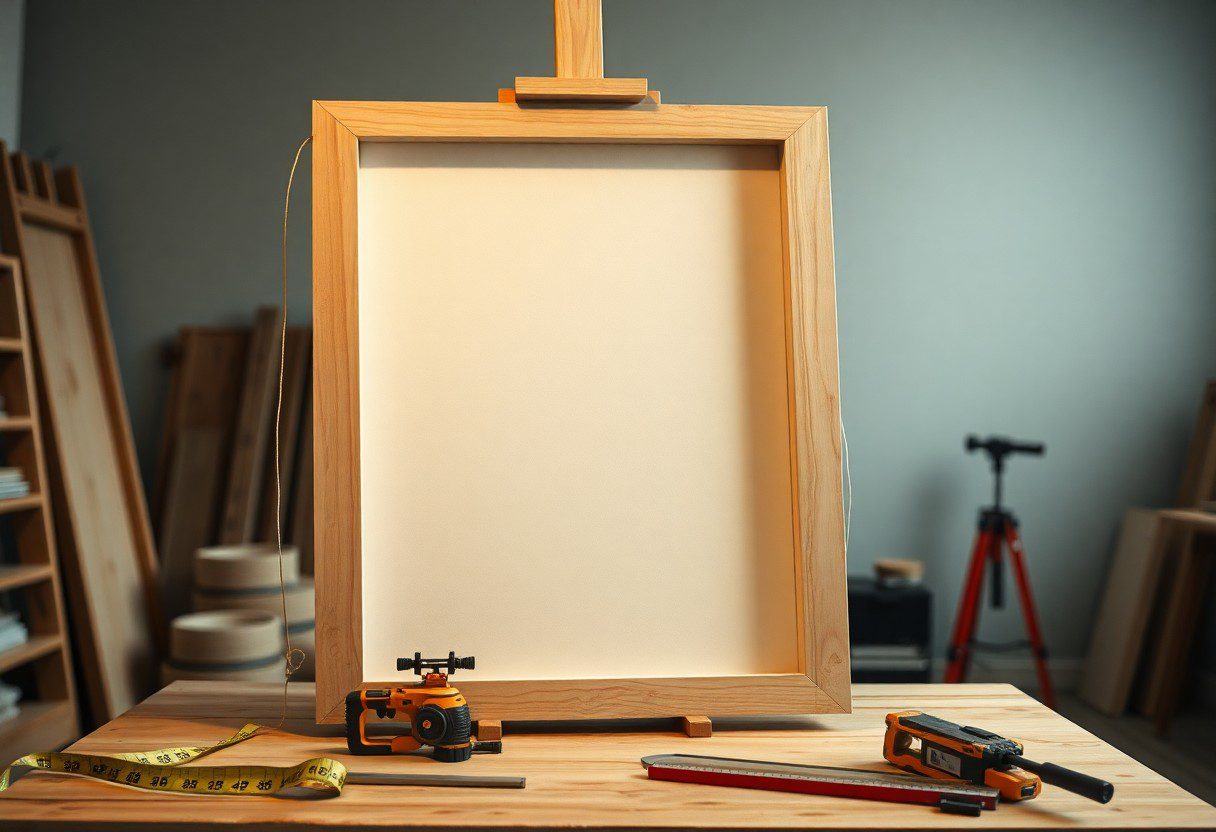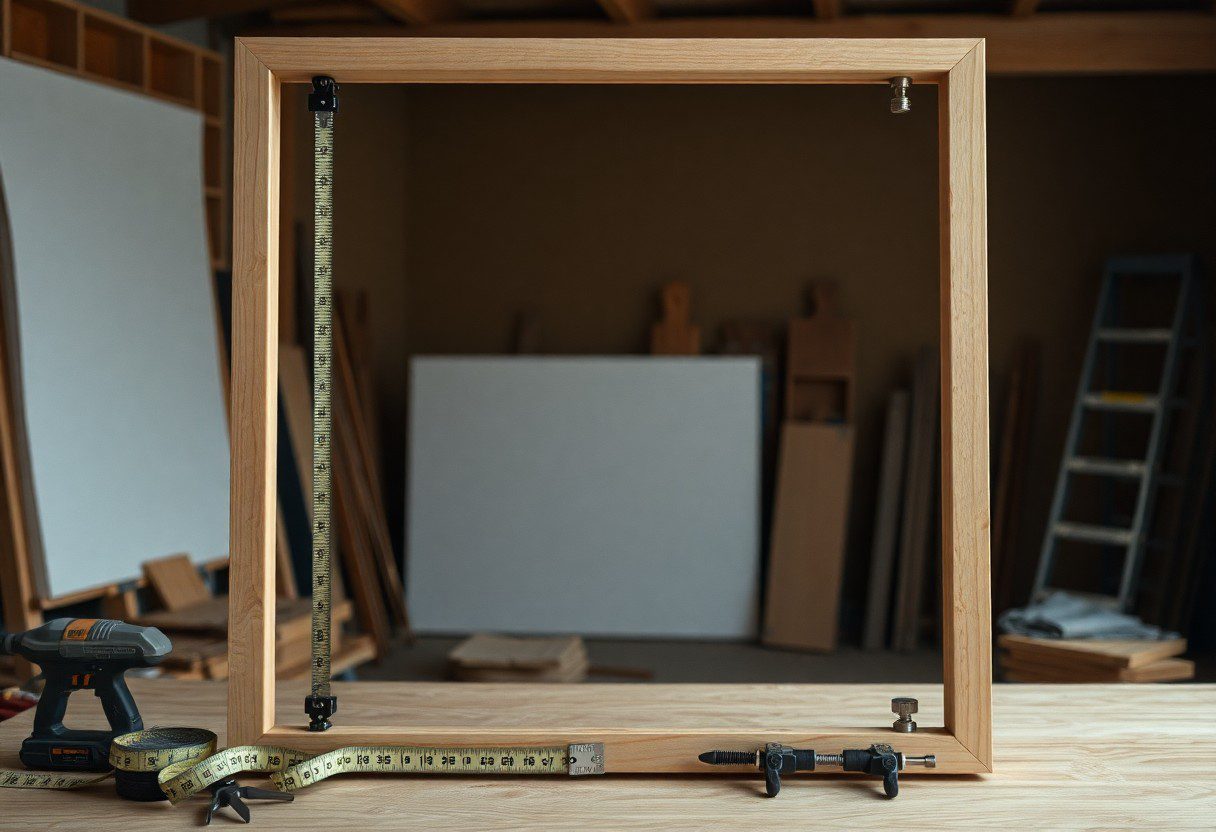Canvas art can truly transform your space, but providing it with an elegant frame elevates it even more. By following simple steps and using affordable materials, you can create a beautiful frame that enhances your artwork while protecting it from damage. In this guide, you’ll learn the crucial techniques and tools needed to construct your own custom frame, ensuring that your canvas remains a highlight in your home decor.
Understanding Canvas Framing
Your canvas deserves a well-crafted frame that enhances its beauty and fit seamlessly with your decor. Framing not only provides aesthetic appeal, but also ensures the longevity of your art by protecting it from damage and environmental changes. The right frame will highlight your canvas while giving it the support it needs to withstand time and elements.
Importance of a Good Frame
There’s no denying that a good frame elevates your canvas from a simple piece of artwork to a stunning centerpiece. A well-chosen frame protects your art and adds a touch of elegance, drawing attention to the piece while providing a finished look. Additionally, a quality frame can increase the value of your artwork, making it a worthwhile investment.
Types of Canvas Frames
Canvas frames are not one-size-fits-all; different types serve unique purposes. Here are some common options:
- Gallery Wrap
- Traditional Frame
- Floating Frame
- Shadow Box Frame
- Custom Frame
Knowing your options can help you choose the best frame for your artwork.
| Type | Description |
| Gallery Wrap | Canvas is wrapped around the frame, no visible edges. |
| Traditional Frame | A wooden frame that surrounds the canvas. |
| Floating Frame | Canvas appears to float within the frame. |
| Shadow Box Frame | Deep frame allowing for layered effects with items. |
| Custom Frame | Personalized options tailored to your specific canvas. |
This selection of canvas frames is designed to meet various aesthetic preferences and practical needs. You might prefer the gallery wrap for a modern look or the traditional frame for classic elegance. Each type can drastically affect how your artwork is perceived. Don’t hesitate to explore floating frames for a sophisticated twist or shadow box frames for added depth. No matter your choice, ensure it complements your canvas. Knowing your frame types will enhance your understanding of the finishing touches to your artwork.
- Gallery Wrap
- Traditional Frame
- Floating Frame
- Shadow Box Frame
- Custom Frame
Knowing the details will enrich your canvas framing journey, ensuring your artwork looks outstanding.
Selecting Materials
The selection of materials for your canvas frame significantly impacts both aesthetics and longevity. You can choose between wood, metal, or even composite materials based on your personal style and the environment in which the frame will be displayed. Consider how these materials will complement your artwork and how they will hold up over time, ensuring that they add value to your piece rather than detract from it.
Wood vs. Metal Frames
Materials such as wood and metal offer different pros and cons. Wood frames provide a classic, warm aesthetic that works well with various décor styles, but they may be prone to warping over time. On the other hand, metal frames deliver modern appeal and superior durability, making them resistant to the elements. Choosing between these options depends on your artistic vision and where the frame will be displayed.
Quality Materials for Durability
To ensure your canvas frame withstands the test of time, opt for high-quality materials. Investing in solid wood or premium metal not only enhances the visual appeal of your frame but also contributes to its sturdiness. While lower-cost options might be tempting, they often lead to quick deterioration and may require frequent replacements, ultimately costing you more in the long run.
A well-constructed frame showcases your artwork effectively and provides important support. Using materials like oak or aluminum can prevent issues like warping and bending, preserving the integrity of your canvas. Additionally, choosing non-toxic finishes enhances the longevity of your frame while promoting a healthier environment. Prioritizing quality will ensure that your frame remains a beautiful part of your décor for years to come.
Measuring for the Frame
It’s imperative to measure your canvas accurately before crafting a frame. Begin by determining the dimensions of your canvas to ensure a perfect fit. This ensures that your artwork is showcased beautifully without any strain on the materials, creating a seamless and appealing presentation.
Taking Accurate Measurements
An important step in the process is to measure both the height and width of your canvas. Use a tape measure and note each dimension carefully, ensuring you account for any irregularities in the canvas edges. Taking these measurements twice can help eliminate any potential errors, resulting in a snug and professional-looking frame.
Considering Canvas Thickness
Canvas thickness plays a vital role when designing your frame. Accurate measurements of the canvas’ depth will inform you how wide your frame needs to be to accommodate the artwork comfortably, preventing any tight fit that might damage the canvas or create an uneven appearance.
Accurate framing considers the depth of your canvas, which can vary widely between different types of canvases. If your canvas is thicker, ensure you choose a frame that provides enough depth to fit around it without squeezing. It’s advisable to leave extra space for a matting board if that’s part of your design. Take into account the potential impact on your frame choice, as a snug fit may compromise the integrity of your artwork, leading to potential wear or damage over time.
Tools Needed for Frame Construction
Many aspiring artists and DIY enthusiasts find themselves excited to build their own canvas frame. To successfully complete this project, you’ll need a selection of tools that will assist you in both measuring and assembling the frame. Gathering the right tools in advance can save you time and ensure your frame turns out beautifully, allowing you to focus on the artistic part of the process.
Essential Tools
While you can attempt to make a canvas frame with minimal resources, having some crucial tools on hand will greatly enhance your project. You’ll require a miter saw or hand saw, a measuring tape, a square, wood glue, and finishing nails. These tools will enable you to cut, measure, and assemble your frame accurately, ensuring a sturdy and reliable base for your canvas.
Optional Tools for Precision
An array of optional tools can help you achieve greater precision during your frame construction. Investing in tools such as a router, corner clamps, and a pneumatic nail gun can elevate the quality of your work. While not necessary, these tools can make the process smoother and more professional, potentially saving you time and effort.
The router allows you to create clean edges and grooves, enhancing the overall design of your frame. Corner clamps ensure that your corners are perfectly aligned while assembling, which can greatly improve the final appearance. Lastly, a pneumatic nail gun not only speeds up the assembly but also provides a secure and reliable hold; however, take care when using it as it is a powerful tool that requires proper handling to avoid accidents. With these optional tools at your disposal, your canvas frame project can achieve a level of professionalism that impresses.
Step-by-Step Frame Construction
Despite the simplicity of frame construction, it requires attention to detail to ensure a sturdy and attractive result. This section will guide you through the important steps, making your DIY project successful.
Materials and Tools
| Materials | Wood (1×2 or 1×3 boards), Wood Glue, Wood Screws, Finishing Nails |
| Tools | Miter Saw, Drill, Measuring Tape, Square, Sandpaper |
Cutting and Assembling the Frame
Any inaccuracies in cutting can lead to a misaligned frame. Start by measuring the dimensions of your canvas, then use a miter saw to cut your wood at appropriate lengths. Be sure to check each cut with a square to guarantee they are straight and accurate. Once cut, lay out the pieces and apply wood glue for secure bonding as you assemble them into a rectangle. Reinforce the corners with wood screws for added strength.
Finishing Touches for Aesthetics
Aesthetics play a significant role in frame construction. You can choose to stain or paint the wood to match your canvas and decor, enhancing its overall appeal. Sand the frame lightly before applying your finish for a smooth surface.
Another important aspect of aesthetics is the choice of finish. You have options like a natural wood stain that highlights the grain or a bold paint color for a modern flair. Applying a sealant after finishing can add durability and prevent wear over time. Additionally, consider adding decorative elements like corner brackets or molding to make your frame stand out. This can elevate the visual appeal of your artwork and enhance your overall decor.
Tips for Displaying Your Framed Canvas
Now that you have your beautiful frame ready, it’s time to make sure it shines in your space. Consider these tips for an eye-catching display:
- Choose a wall with good lighting to enhance your canvas.
- Group multiple frames for a cohesive look.
- Use your canvas as a focal point in your room.
- Vary heights by mixing different frame sizes.
After you’ve followed these suggestions, your framed canvas will be a stunning addition to your decor.
Choosing the Right Wall Space
On selecting the ideal wall space, consider the scale of your canvas and the surrounding decor. Look for a wall that can accommodate your artwork without overshadowing it. A blank, large wall can be perfect for a statement piece, while a smaller canvas might look more effective in cozy corners or snug spaces.
Best Practices for Hanging
Wall placement is vital for showcasing your canvas beautifully. When hanging your artwork, ensure it is at eye level (about 57-60 inches from the floor) for optimal viewing. Use a level tool to keep it straight and consider utilizing wall anchors for heavier frames to ensure stability. Maintain balance by spacing pieces adequately if you’re showcasing a gallery wall. This technique will prevent overcrowding and lend your display a polished look.
Displaying your framed canvas properly can transform your space. Ensure you use the proper hanging hardware for stability and avoid damages by checking the weight limits. Always choose a spot that accentuates your canvas’s colors and design. Consider factors like light exposure and nearby furniture; too much light can fade colors over time. With careful planning, your framed canvas can become a cherished centerpiece that adds character to your home.
Final Words
As a reminder, making a frame for your canvas is a straightforward process that enhances the presentation of your artwork. Start by measuring your canvas accurately and selecting suitable materials, like wood or metal, to create a sturdy frame. Assemble the pieces with precision, ensuring that all corners are square and secure. Finally, finish your frame with paint or stain to suit your aesthetic preference. With these steps, you’ll achieve a beautiful frame that complements and protects your canvas, adding an elegant touch to your art display.
FAQ
Q: What materials do I need to make a frame for a canvas?
A: To make a frame for a canvas, you will need the following materials: wooden furring strips or ready-made frame kits, wood glue, wood screws or nails, a saw (preferably a miter saw), a measuring tape, a square, sandpaper, and finish (like paint or stain) if you want to enhance the appearance of the frame.
Q: How do I measure my canvas for the frame?
A: To measure your canvas, start by measuring its height and width. Add an additional half inch to both the height and width to account for the spacing and fit. Ensure you measure the canvas diagonally to confirm it is square, as this will affect the frame sizing.
Q: What are the steps to cut the wood for the frame?
A: Once you have measured your canvas, cut the wood at a 45-degree angle using the miter saw. Each piece should be slightly longer than your canvas measurements to accommodate the overlap at the corners. Make sure to cut two pieces for the height and two for the width.
Q: How do I assemble the frame?
A: To assemble the frame, lay the cut pieces on a flat surface. Use wood glue to join the mitered edges and secure the frame together. Alternatively, you can use wood screws or nails for added stability. Ensure the corners are square before the glue sets. Clamp the frame if necessary while it dries.
Q: What is the best way to hang the canvas in the frame?
A: To hang the canvas in the frame, place it face down inside the frame. You can secure it using L-brackets, metal clips, or by applying small points of hot glue to hold the canvas in place. Ensure the canvas is stretched evenly over the frame to maintain its shape and prevent sagging.
Q: How can I finish the frame for a polished look?
A: To finish the frame, start by sanding the edges and surfaces to create a smooth finish. Apply a coat of paint or stain to match your decor. If you prefer a natural wood look, consider applying a clear varnish to protect the wood while allowing the grain to show through. Allow it to dry completely before hanging.
Q: Can I create a custom frame design for my canvas?
A: Yes, you can create a custom frame design to suit your personal style. You can use varied types of moulding, stained or painted wood, or even decorative elements like carvings or embellishments. Additionally, you can experiment with layering multiple frames for a unique, visually appealing look.




